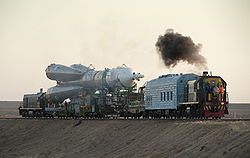Baikonur Cosmodrome
Baikonur Cosmodrome (Russian: Космодро́м Байкону́р; Kazakh: [Байқоңыр ғарыш айлағы] Error: {{Lang}}: text has italic markup (help)) is a spaceport in southern Kazakhstan. It is the first and most active space port in the world.[1] It is leased to Russia until 2050, and is managed by Roskosmos and the Russian aerospace forces. It was originally built by the Soviet Union in the late 1950s. There are many commercial, military and scientific rocket launches each year [2] All crewed Russian spaceflights are launched from Baikonur.
| Baikonur Cosmodrome Russian: Космодром Байконур Kosmodrom Baykonur | |||
|---|---|---|---|

| |||
| Baikonur Cosmodrome's "Gagarin's Start" Soyuz launch pad before the rollout of Soyuz TMA-13, 10 October 2008. | |||

| |||
| A Soyuz rocket takes off from Baikonur | |||
| IATA: none – ICAO: none – LID: GC0015 | |||
| Summary | |||
| Airport type | Spaceport | ||
| Owner/Operator | |||
| Location | Kazakhstan | ||
| Elevation AMSL | 90 m / 300 ft | ||
| Coordinates | 45°57′54″N 63°18′18″E / 45.96500°N 63.30500°E | ||
Sputnik 1, the first artificial satellite, was launched from Baikonur in 1957. Vostok 1, the first human spaceflight, was also launched from Baikonur, carrying Yuri Gagarin. The launchpad used for both of these missions was renamed Gagarin's Start.
Baikonur Cosmodrome Media
A U-2 spy plane photograph of R-7 launch pad in Tyuratam, taken on 5 August 1957
A Soyuz rocket is erected into position at the Baikonur Cosmodrome's Pad 1/5 (Gagarin's Start) on 24 March 2009. The rocket launched the crew of Expedition 19 and a spaceflight participant on 26 March 2009.
OK-MT (foreground) and OK-1.02 (background) in storage at Baikonur Cosmodrome in 2020.
Buran test article OK-ML-1 at Baikonur Museum
The Sputnik 1 satellite test model is shown at the Baikonur Cosmodrome Museum of Space History in Kazakhstan.
References
- ↑ "NASA-Baikonur Cosmodrome". Archived from the original on 1 March 2021. Retrieved 25 June 2018.
- ↑ "Baikonur Cosmodrome". International Launch Services.






